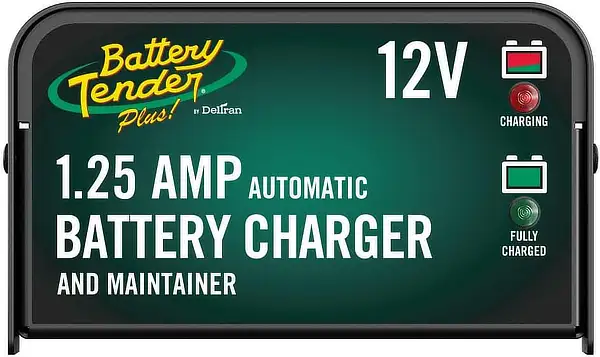Battery State-Of-Charge Chart | 12 Volt Battery Voltage & Specific Gravity

Battery voltage, (chart below) can help determine its state of charge. I have researched 12v lead acid battery voltage readings versus percent charge (state of charge) which you may find useful or helpful. I have voltages for 6v, 12v, 24v, and 48v.
There are important caveats to this type of measurement (listed below) regarding measuring battery voltage to determine how charged it is..
The ‘State Of Charge’ (SOC) of a battery. It is a measurement of how much energy is remaining (percent). It’s like a fuel gauge. Measuring and knowing the SOC of a battery or battery bank is useful when applying to alternative energy, or any other situation where you need to know its condition.
There are several ways to determine a battery’s SOC.
1. Measure the battery’s chemistry (specific gravity) with a hydrometer (accurate method).
2. Measure its voltage with a volt meter while open-circuit, no load (general approximation).
3. Track the current flow in and out of the battery with a ‘shunt’ and associated metering circuit (common with alt-energy systems).
>> Battery Hydrometer
The most popular hydrometer on amzn is used for measuring the specific gravity of a lead acid battery with access to its chemistry.
I put together the following battery state-of-charge chart which indicates the state-of-charge (percent) as it relates to battery voltage or specific gravity. Voltages and Specific Gravity are listed for a 6-volt or 12-volt battery, and battery banks of 24 and 48 volts.
The chart is listed below. But first, a few important notes and caveats…
How I Made The Battery State of Charge Chart
How I determined the voltage values:
I researched many battery manufacturers regarding their own published SOC data. Some were slightly different from each other regarding their SOC values. However, I averaged all of them together to come up with a chart that represents what I believe to be a good GENERAL indication.
Battery Voltage Measurements Are Just Approximation
Note: Voltage measurements are only approximate to determine SOC. Measuring battery voltage is NOT the most accurate way to do this (there are variables to consider). But it is a good generalization. A more accurate method is to measure the specific gravity of each cell within the battery. However, for many batteries, this is difficult or impossible (AGM batteries, for example). Many (most) alt-energy systems incorporate a DC-shunt which keeps track of SOC by monitoring the current flow in and out of the battery or battery bank, which is a very accurate way to track state-of-charge.
Measure Battery While “At Rest” “Open Circuit”
For best accuracy when measuring battery voltage, the battery must be in an ‘open circuit’ condition (at rest, or ‘resting’).
This means that the battery must NOT be under load, and it must NOT be charging.
To be somewhat accurate, the battery should be in that condition for an hour or two before taking a measurement, while for a more accurate measurement, you should wait 6 hours up to 24 hours.
Battery Voltage vs Temperature
Battery voltages are temperature-dependent. In fact, good charger systems (alt-energy systems) have temperature compensation built-in via a temp probe on the battery. The voltage data in the chart below is based on manufacturer specs. (temperature within the vicinity of room temperature).
Hydrometer Battery Measurement Tip
Note: If testing specific gravity (deep-cycle flooded/wet batteries), when drawing a sample from the battery, fill and drain the hydrometer several times before settling upon a measurement. One of my previous battery banks was a set of 6v lead acid batteries. I measured them regularly and noticed more accuracy when doing it the way I just described.
Keep Lead Acid Batteries Above 50% State of Charge
For longer battery life, lead acid batteries should remain at 50% or more state of charge. The less you draw it down, the more charge cycles you will get out of it over its life. Occasional dips below 50% may not be harmful, but continual discharges to those levels will shorten battery life considerably.
Generally speaking, the less you discharge the battery before recharge, the longer the battery will last. Most alternative-energy systems using lead-acid chemistry and/or AGM type, are designed to keep the battery bank at least 50% or higher. I try not to let my battery bank drop below 70% (AGM batteries configured at 48v).
The Voltage of a Fully Charged Battery is NOT the Charging Voltage
The 100% state of charge voltage is NOT the recommended charging voltage (which will be higher, and multi-stage). See your battery manufacturer’s recommendations regarding charging voltage specs.
Here’s the battery voltage chart:
BATTERY VOLTAGE – STATE OF CHARGE CHART
Open circuit voltage, or specific gravity per cell

>> Download full-size PDF (Battery State Of Charge)
If you know your exact battery, you might find related voltage information on the manufacturer’s website. But the chart above will provide a very good general view of the state of charge.
Charger Maintainer for 12v battery
I use the Battery Tender Plus for charging/maintaining (trickle charging) my various 12v batteries. Mowers, 4-wheelers, snowmobiles, generators, etc.. It’s the most popular of its type on the market. I’ve had two in operation for many years. Great product.
Battery Tender Plus
(view on amzn)

[ Read: Lead Acid Batteries – State Of Charge versus Freezing Temperature ]
